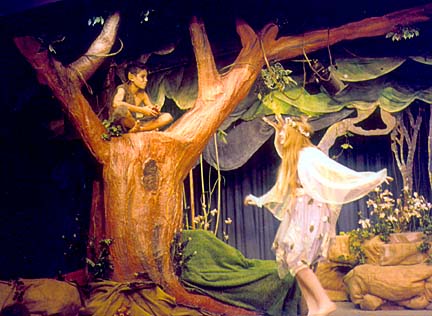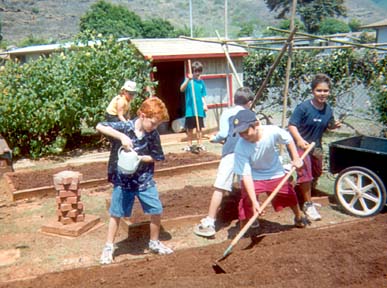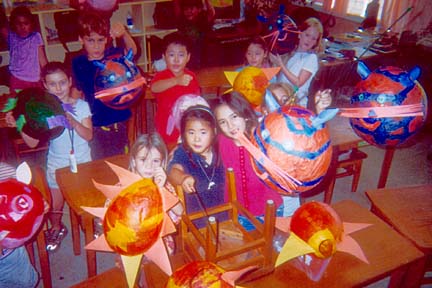
HONOLULU WALDORF SCHOOL
Each year eighth graders at the Honolulu Waldorf School produce a play. Last year they performed "A Midsummer Night's Dream."
Waldorfaire blends
history and culture
to build kids’ character
On my way to pick up my daughter from her Kindergarten class, I noticed small, pencil-marked graffiti marring the surface of a wall I pass nearly every day. I leaned in close -- the writing was so "chicken-scratch" and small -- to see. It read, "Waldorf School is a Harry Potter school."
'Waldorfaire'
When: 10 a.m. to 4 p.m. Saturday
Where: The Honolulu Waldorf School, 350 Ulua St., Hawaii Kai
Activities: Maze, climbing wall, dunking booth, pony rides, petting zoo, hair and face painting, circus stunt workshop, mad scientist shop, games, fortune-telling, massage (childcare available during treatments), children's and country stores, white elephant sale, food booths, puppet shows
Admission: Free
Call: 377-5471
As I laughed about that sassy little statement about Honolulu Waldorf School, I had no trouble imagining its inspiration. The most obvious source for such a declaration would be the school's annual Waldorfaire, which is unique in its charms -- and for what it doesn't offer.
At the Waldorfaire, there are no mechanized rides with flashing lights, no screeching arcade games, no bouncers decorated with cartoon characters or loud, recorded music. Rather, the entertainment includes jousting, storytelling, student performances and puppet shows. Activities include pony rides, circus stunt workshops, and even fortune-telling and massage. Prizes for young children are simple handmade toys reflective of nature or made of natural materials.
Indeed, with regard to what most of us are accustomed to experiencing, the faire bears more likeness to Harry Potter's realm than E.K. Fernandez's. But why does the Waldorfaire offer jousting and puppet shows in lieu of Ferris wheels and video games?
MUCH OF what constitutes the Waldorfaire is rooted in the Waldorf curriculum. The circus stunts, for instance, are taken from the sixth graders' study of medieval history, and in particular, minstrel performers.
History bridges with culture and physical education as the students learn juggling, unicycle riding and tumbling. And when students take part in offering these activities at the faire, they cultivate their social skills and altruistic sensibilities, says Frances Alewives, the school's College Chair and a Waldorf teacher for 20 years.
"The children are working together, and all this effort and practice benefits them while also benefiting the community," she says. "The whole idea of 'doing' reinforces understanding, and anything we learn as human beings should be carried to fruition."
The fruition Altwies speaks of is guided by more than an intellectual understanding. It also engages the keikis' emotional and moral sensibilities. This perspective reflects the Waldorf approach to education: "Each child is embraced as a unique spiritual, physical and intellectual being," the Honolulu Waldorf School Web site states.
The inclusion of spirituality and morality in the Waldorf philosophy seemingly contradicts claims that the curriculum is nonsectarian. But Altwies separates religion from these concepts.
"Morality is about how our actions affect each other," she says. "We talk about morality in terms of guiding healthy, willful actions."
Altwies illustrates how morality is incorporated with academics through a lesson she taught on the science of magnetism. "I began with a story first, about how magnets were discovered by Roman soldiers who had metal studs in their shoes. They traveled through a part of Asia where the soil was magnetized, so they had a hard time walking.
"Then later, I talked about a magnetic personality, how you can be drawn to someone. In junior high, the children understand this concept. It lives in them.
"So we connect the subject to human experience. Then we explore what's valuable and how we can use this knowledge in a way that's responsible and helpful to all humanity," Altwies says.
Likewise, Waldorf schools address spirituality as a trait of humanity that must be nurtured and revered.
"We teach a reverence for the human being. People are more than just their physical bodies and their minds. There's a deeply spiritual aspect to being human," Altwies says. "There's a difference between religion and spirituality. Each religion has its specific dogma. But we respect what is universally spiritual in a human being."
MY DAUGHTER AND I travel from Waipahu to Niu Valley every morning in rush-hour traffic to the Waldorf school. It's not easy. We're on the road before the sun is up, tired and grouchy as we face the long commute. She whines and I scold. But I anticipate the lessons that await when we get to school, and my resolve settles in.
HONOLULU WALDORF SCHOOL
The Honolulu Waldorf School garden takes shape under the industrious care of third graders, who spend the year learning about farming and gardening.
I envision the classroom, painted an inviting pink pastel, with a round pink rug at its center. Wood furniture is unpainted to display a natural beauty, as do most of the toys. Woven baskets are filled with shells and seeds, marbles and blocks. Silk scarves in every color are draped over another basket, and rag dolls rest in a wooden cradle. This environment never fails to soothe us.
Best of all, with the room comes my daughter's teacher, a calm, cheerful woman whose warmth melts away our morning frustrations.
It may seem that we just lucked out -- a nice teacher in a nice classroom -- but in the Waldorf curriculum, little is left to chance.
"Young children are still learning about the world through their senses, so we want everything they come in contact with to be real, not artificial," says Geri Ihara, a Waldorf preschool/kindergarten teacher for 12 years. "We want it to be real and beautiful."
Ihara says that in most settings for children, the environment is decorated in bright primary colors to attract their attention. "It's like 'Sesame Street,' bright and loud and catchy. Get their attention and then teach them."
But she says that when children come to a classroom devoid of bells and whistles, "they relate to (the materials), and they're more into the function rather than the attraction.
"It draws them in naturally. It's like the beach. There's no need for fancy toys. They just dig in the sand and play in the water," Ihara says.
Likewise, the behavior of the adult around the children must be honest. "They take everything at face value."
A serene setting, basic toys and a teacher who is true create "quietness," says Ihara. "Even if the children arrive boisterous -- and they do -- at the core of the classroom is this subtlety of quiet. Everyone's life is so busy, it's like hyperventilating. This mood allows the children to take a natural breath. This environment provides quiet so that the children can work out all the social challenges of school and get into their creativity."
PUPPET SHOWS are instrumental in bolstering creativity and imagination in the Waldorf Kindergarten. They are a staple of the Waldorfaire as well.
HONOLULU WALDORF SCHOOL
The St. Martin's Lantern Festival, one of the many festivals the Honolulu Waldorf School observes, is held in October to honor a Roman soldier who helped the poor. Waldorf second graders make their own lanterns to carry during the festival.
"Storytelling and puppet shows are a foundation for the children," says Altwies. "Children develop imaginative and creative power through stories because at that age, they live in their imagination."
The Kindergarten listen to stories, rather than reading them, in the fashion of oral traditions, which is filled with imagery, adjectives and complex phrasing.
"Traditional language is a pictorial language that is richer than the kind of simple sentences a young child can read," Altwies says. "This builds a fuller language experience, and we find that when the children take their SATs later, their listening skills are acute.
"This is why the puppets are very simple in our puppet shows, without faces or features. It allows the children to complete the images in their imagination. The whole idea of flexibility of imagination is that it leads to flexibility in thinking."
IN THE KINDERGARTEN, as in everywhere else at the school, cultivating the child's morality seems equally important to cultivating the mind. Ihara calls it "teaching reverence."
"Reverence is not just honoring the individual, but honoring everything -- the care we take with the toys, the care we take with the rhythm of the day. Everything is honored, even the smallest thing," Ihara says. "When I do 'circle time,' we sing a song about a vendor selling fruit. My emphasis is on the gestures we do of giving and receiving the money, the gestures of the hands. Even that is morality, reverence. Saying 'please' and 'thank you' with their hands -- the children may not understand it right away, but after a while, it starts to have meaning."
Ihara says the youngsters play in the schoolyard barefoot, and on muddy days, the teachers take out metal buckets and fill them with water. Right outside the classroom door, the children step into the buckets to rinse their feet. When they step out and into the classroom, a classmate is waiting with a cloth to wipe their feet dry.
"The children are servicing a friend; they're taking care of them. These little acts and gestures build up the children's reverence for each other," Ihara says. "Even though they may sometimes hit or say mean things, it's wonderful to see the balance.
"In my class, when little Reilly is crying, the older children are scrambling around trying to find her Buddy (stuffed animal) to comfort her. They see each other do this and it encourages them.
"As a teacher, I like to find the balance and cultivate it. If a child is aggressive, I like to see their soft side with a younger child. That's the spiritual part, to not only see the outside behavior, but to see the acts of kindness and know that the child is glowing inside."
First school opened
Rudolf Steiner, an Austrian scientist, artist and philosopher, founded the first Waldorf school in 1919 in Stuttgart, Germany.
in 1919 in GermanyHis educational philosophy addresses each child spiritually, intellectually, morally and physically.
Today, there are 800 Steiner schools worldwide, including the Honolulu Waldorf School, Haleakala Waldorf School on Maui, and Kona Pacific School and Malamalama Waldorf School on the Big Island.
Star-Bulletin staff
Click for online
calendars and events.



